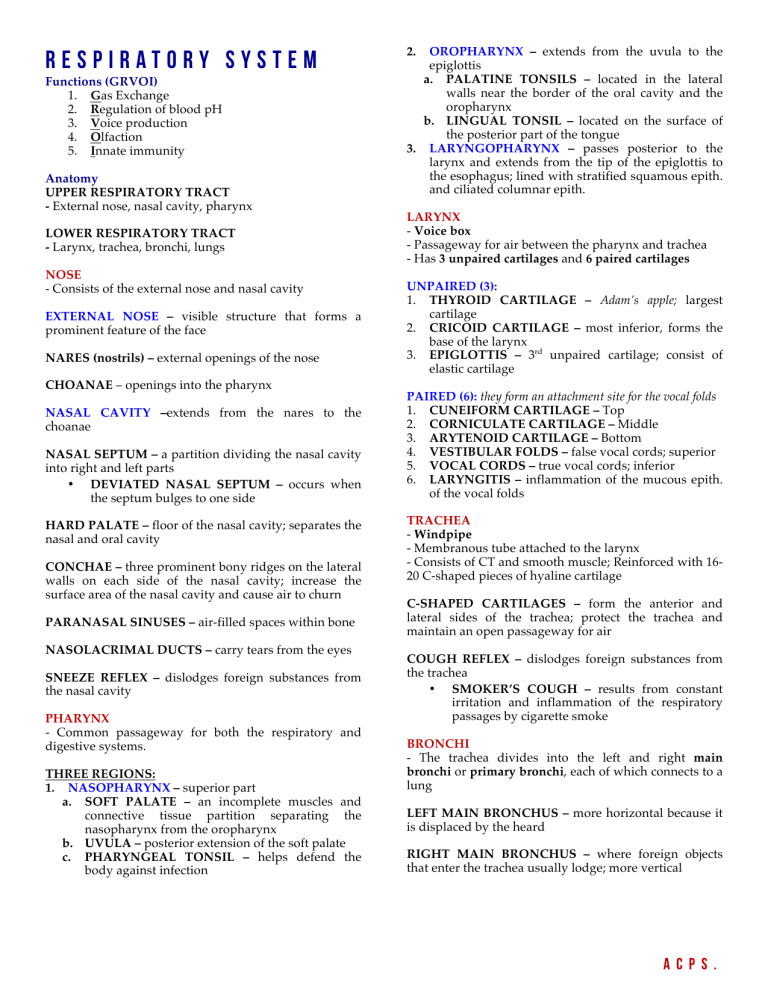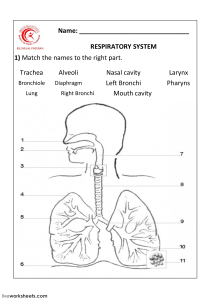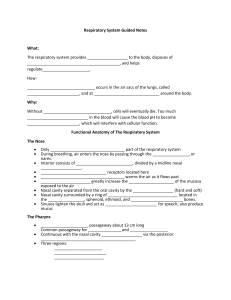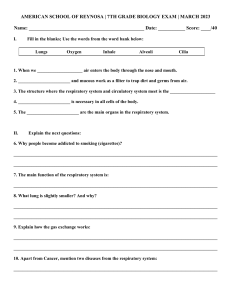
Respiratory System Functions (GRVOI) 1. Gas Exchange 2. Regulation of blood pH 3. Voice production 4. Olfaction 5. Innate immunity Anatomy UPPER RESPIRATORY TRACT - External nose, nasal cavity, pharynx LOWER RESPIRATORY TRACT - Larynx, trachea, bronchi, lungs NOSE - Consists of the external nose and nasal cavity EXTERNAL NOSE – visible structure that forms a prominent feature of the face NARES (nostrils) – external openings of the nose CHOANAE – openings into the pharynx NASAL CAVITY –extends from the nares to the choanae NASAL SEPTUM – a partition dividing the nasal cavity into right and left parts • DEVIATED NASAL SEPTUM – occurs when the septum bulges to one side HARD PALATE – floor of the nasal cavity; separates the nasal and oral cavity CONCHAE – three prominent bony ridges on the lateral walls on each side of the nasal cavity; increase the surface area of the nasal cavity and cause air to churn PARANASAL SINUSES – air-filled spaces within bone NASOLACRIMAL DUCTS – carry tears from the eyes SNEEZE REFLEX – dislodges foreign substances from the nasal cavity PHARYNX - Common passageway for both the respiratory and digestive systems. THREE REGIONS: 1. NASOPHARYNX – superior part a. SOFT PALATE – an incomplete muscles and connective tissue partition separating the nasopharynx from the oropharynx b. UVULA – posterior extension of the soft palate c. PHARYNGEAL TONSIL – helps defend the body against infection 2. OROPHARYNX – extends from the uvula to the epiglottis a. PALATINE TONSILS – located in the lateral walls near the border of the oral cavity and the oropharynx b. LINGUAL TONSIL – located on the surface of the posterior part of the tongue 3. LARYNGOPHARYNX – passes posterior to the larynx and extends from the tip of the epiglottis to the esophagus; lined with stratified squamous epith. and ciliated columnar epith. LARYNX - Voice box - Passageway for air between the pharynx and trachea - Has 3 unpaired cartilages and 6 paired cartilages UNPAIRED (3): 1. THYROID CARTILAGE – Adam’s apple; largest cartilage 2. CRICOID CARTILAGE – most inferior, forms the base of the larynx 3. EPIGLOTTIS – 3rd unpaired cartilage; consist of elastic cartilage PAIRED (6): they form an attachment site for the vocal folds 1. CUNEIFORM CARTILAGE – Top 2. CORNICULATE CARTILAGE – Middle 3. ARYTENOID CARTILAGE – Bottom 4. VESTIBULAR FOLDS – false vocal cords; superior 5. VOCAL CORDS – true vocal cords; inferior 6. LARYNGITIS – inflammation of the mucous epith. of the vocal folds TRACHEA - Windpipe - Membranous tube attached to the larynx - Consists of CT and smooth muscle; Reinforced with 1620 C-shaped pieces of hyaline cartilage C-SHAPED CARTILAGES – form the anterior and lateral sides of the trachea; protect the trachea and maintain an open passageway for air COUGH REFLEX – dislodges foreign substances from the trachea • SMOKER’S COUGH – results from constant irritation and inflammation of the respiratory passages by cigarette smoke BRONCHI - The trachea divides into the left and right main bronchi or primary bronchi, each of which connects to a lung LEFT MAIN BRONCHUS – more horizontal because it is displaced by the heard RIGHT MAIN BRONCHUS – where foreign objects that enter the trachea usually lodge; more vertical ACPS. LUNGS - Principal organs of respiration RIGHT LUNG – has 3 lobes (superior, middle, inferior) LEFT LUNG – has 2 lobes (superior, inferior) - The lobes of the lungs are separated by deep, prominent fissures on the lung surface. - Each lobe is divided into Bronchopulmonary segments separated from one another by CT septa. - The main bronchi branch many times to form the TRACHEOBRONCHIAL TREE. • MAIN BRONCHI • LOBAR BRONCHI – Secondary bronchi o SEGMENTAL BRONCHI – Tertiary bronchi § BRONCHIOLES • TERMINAL BRONCHIOLES o RESPIRATORY BRONCHIOLES § ALVEOLAR DUCTS – long, branching hallways with many open doorways • ALVEOLI – Small air sacs RESPIRATORY MEMBRANE OF THE LUNGS – where gas exchange between the air and blood takes place - It is very thin to facilitate the diffusion of gases - Consists of 6 LAYERS: 1. Thin layer of fluid lining the alveolus 2. Alveolar epithelium – composed of simple squamous epithelium 3. Basement membrane of the alveolar epith. 4. Thin interstitial space 5. Basement membrane of the capillary endothelium 6. Capillary endothelium – simple squamous epith. PLEURAL CAVITIES - surround the lungs and provide protection against friction VENTILATION AND RESP. VOLUMES VENTILATION (breathing) – the process of moving air into and out of the lungs. 2 PHASES: 1. INSPIRATION – inhalation; movement of air into the lungs 2. EXPIRATION – exhalation; movement of air out of the lungs CHANGING THORACIC VOLUME MUSCLES OF INSPIRATION – include the diaphragm and the muscles that elevate the ribs and sternum, such as the external intercostals • DIAPHRAGM – a large dome of skeletal muscle that separates the thoracic cavity from abdominal cavity MUSCLES OF EXPIRATION – internal intercostals; depress the ribs and sternum. PRESSURE CHANGES AND AIRFLOW Two physical principles that govern the airflow: 1. Changes in volume result in changes in pressure. 2. Air flows from an area of higher pressure to an area of lower pressure - During INSPIRATION, air flows into the alveoli because atmospheric pressure is greater than the alveolar pressure. - During EXPIRATION, air flows out of the alveoli because alveolar pressure is greater than atmospheric pressure. LUNG RECOIL - The tendency for an expanded lung to decrease in size. - When thoracic volume and lung volume decrease during quiet expiration. - Two factors keep the lungs from collapsing: SURFACTANT and PLEURAL PRESSURE. PLEURA – serous membrane lining the pleural cavity • PARIETAL PLEURA – lines the walls of the thorax, diaphragm and mediastinum • VISCERAL PLEURA – covers the surface of the lung SURFACTANT – reduces the surface tension of the fluid lining the alveoli (surface acting agent). PLEURAL FLUID – acts as a lubricant and helps hold the pleural membranes together CHANGING ALVEOLAR VOLUME - Increasing thoracic volume results in decreased pleural pressure, increased alveolar volume, decreased alveolar pressure, and air movement into the lungs (inspiration). LYMPHATIC SUPPLY SUPERFICIAL LYMPHATIC VESSELS – are deep to the visceral pleura; they drain lymph from the superficial lung tissue and the visceral pleura DEEP LYMPHATIC VESSELS – follow the bronchi; they drain lymph from the bronchi and associated CTs PLEURAL PRESSURE – lower than alveolar pressure, which causes the alveoli to expand. - Decreasing thoracic volume results in increased pleural pressure, decreased alveolar volume, increased alveolar pressure, and air movement out of the lungs (expiration). ACPS. RESPIRATORY VOLUMES & CAPACITIES SPIROMETRY – is the process of measuring volumes of air that move into and out of the respiratory system. SPIROMETER – device that measures the resp. volumes RESPIRATORY VOLUMES – are measures of the amount of air movement during different portions of ventilation RESPIRATORY CAPACITIES – are sums of two or more respiratory volumes RESPIRATORY VOLUMES: 1. TIDAL VOLUME – air inspired or expired with each breath (at rest, quiet breathing = 500mL) 2. INSPIRATORY RESERVE VOLUME – air that can be inspired forcefully beyond the resting TV (3000mL) 3. EXPIRATORY RESERVE VOLUME – air that can be expired forcefully (1100mL) 4. RESIDUAL VOLUME – air still remaining in the respiratory passages and lungs after maximum expiration (1200mL) RESPIRATORY CAPACITIES: 1. FUNCTIONAL RESIDUAL CAPACITY – ERV + RV Ø Amount of air remaining in the lungs at the end of a normal expiration (2300mL) 2. INSPIRATORY CAPACITY – TV + IRV Ø Amount of air a person can inspire maximally after a normal expiration (3500mL) 3. VITAL CAPACITY – IRV + TV + ERV Ø It is the maximum volume of air that a person can expel from the resp. tract after maximum inspiration (4600mL) 4. TOTAL LUNG CAPACITY – IRV + ERV + TV +RV Ø Also equal to the VC + RV (5800mL) GAS EXCHANGE - Gas exchange bet. air and blood occurs in the respiratory membrane DEAD SPACE – the parts of the resp. passageways where gas exchange bet. air and blood does not occur. RESPIRATORY MEMBRANE THICKNESS - Increases in the thickness of the respiratory membrane result in decreased gas exchange. SURFACE AREA - Small decreases in surface area adversely affect gas exchange during strenuous exercise. When the surface area is decreased to 1/3 or 1/4 of normal, gas exchange is restricted under resting conditions. PARTIAL PRESSURE - is the pressure exerted by a specific gas in a mixture of gases, such as air. DIFFUSION OF GASES IN THE LUNGS - O2 diffuses from a higher partial pressure in the alveoli to a lower pp in the pulmonary capillaries. - CO2 diffuses from a higher partial pressure in the pulmonary capillaries to a lower pp in the alveoli. DIFFUSION OF GASES IN THE TISSUES - O2 diffuses from a higher pp in the tissue capillaries to a lower pp in the tissue spaces. - CO2 diffuses from a higher pp in the tissues to a lower pp in the tissue capillaries. GAS TRANSPORT IN THE BLOOD OXYGEN TRANSPORT OXYHEMOGLOBIN – hemoglobin with oxygen bound to its heme groups MORE OXYGEN IS RELEASED HEMOGLOBIN IF (FOUR FACTORS): 1. Partial pressure for O2 is low 2. Partial pressure for CO2 is high 3. pH is low 4. Temperature is high FROM CO2 TRANSPORT AND BLOOD pH CARBONIC ANHYDRASE – enzyme that promotes the uptake of CO2 by RBCs - As CO2 levels increase, blood pH decreases (becomes more acidic) - As CO2 levels decrease, blood pH increases (becomes more basic) RHYTHMIC BREATHING RESPIRATORY AREAS IN THE BRAINSTEM MEDULLARY RESPIRATORY CENTER – establishes rhythmic breathing Ø DORSAL RESPIRATORY GROUPS (2) – primarily responsible for stimulating contraction of the diaphragm. Ø VENTRAL RESPIRATORY GROUPS (2) – primarily responsible for stimulating the external and internal intercostal, and abdominal muscles. o PRE-BOTZINGER COMPLEX – establish the basic rhythm of breathing PONTINE RESPIRATORY GROUP – is a collection of neurons in the pons. - It plays a role in switching between inspiration and expiration. GENERATION OF RHYTHMIC BREATHING - involves the integration of stimuli that start and stop inspiration 1. Starting inspiration 2. Increasing inspiration 3. Stopping inspiration NERVOUS CONTROL OF BREATHING HIGHER BRAIN CENTERS – allow voluntary control of breathing. HERING-BREUER REFLEX – supports rhythmic respiratory movements by limiting the extent of inspiration TOUCH, THERMAL, PAIN stimulate breathing RECEPTORS – can ACPS. CHEMICAL CONTROL OF BREATHING HYPERCAPNIA – a greater than normal amount of CO2 in the blood CARBON DIOXIDE – major chemical regulator of breathing CHEMORECEPTORS (in medulla respond to changes in blood pH oblongata) – CHEMORECEPTORS (in carotid and aortic bodies) – respond to changes in blood O2. HYPOXIA – a condition when blood O2 declines to a low level EFFECT OF EXERCISE ON BREATHING 1. Breathing increases abruptly 2. Breathing increases gradually ANAEROBIC THRESHOLD – the highest level of exercise that can be performed without causing a significant change in blood pH RESPIRATORY ADAPTATIONS TO EXERCISE - Training results in increased minute volume at maximal exercise because of increased TV and respiratory rate. EFFECTS OF AGING ON THE RESP. SYSTEM 1. VC and Maximum min. ventilation decrease 2. RV and dead space increase 3. Increase in resting TV compensates for increased dead space, loss of alveolar walls, and thickening of alveolar walls 4. The ability to remove mucus from respiratory passageways decreases with age ACPS.



